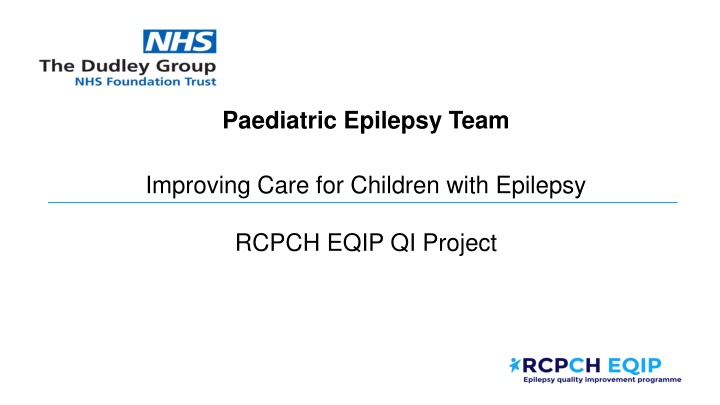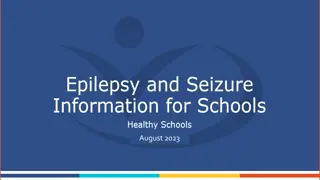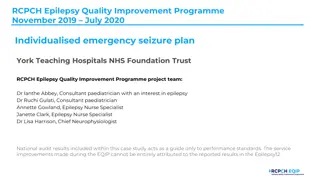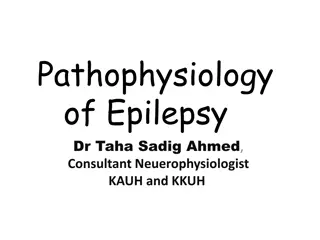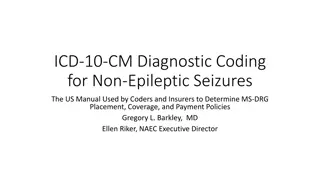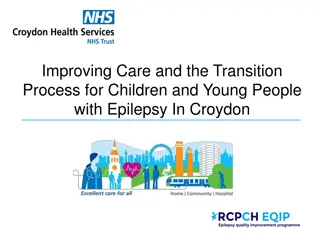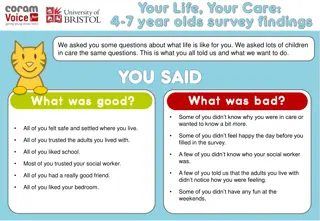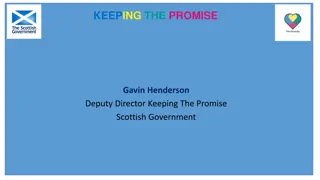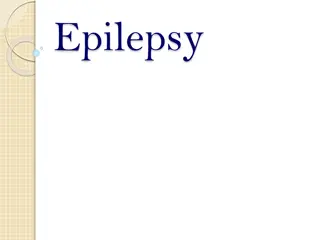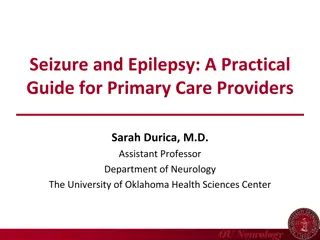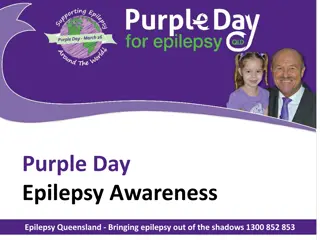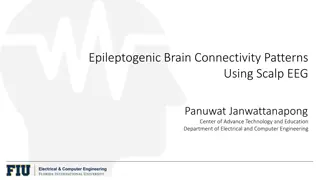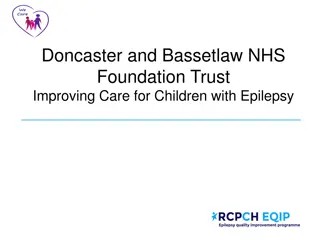Improving Care for Children with Epilepsy - Project Overview
The project aims to reduce patient waiting times for initial appointments in the Epilepsy Clinic by 50%, from 12 weeks to 6 weeks by May 2023. The team identified the need for faster appointments following NICE recommendations and has implemented various strategies to achieve this goal. Initiatives include streamlining referral pathways, increasing patient engagement, and providing support materials to reduce anxieties. Through data analysis and collaborative efforts, the team is working towards enhancing care delivery for pediatric epilepsy patients.
Download Presentation

Please find below an Image/Link to download the presentation.
The content on the website is provided AS IS for your information and personal use only. It may not be sold, licensed, or shared on other websites without obtaining consent from the author.If you encounter any issues during the download, it is possible that the publisher has removed the file from their server.
You are allowed to download the files provided on this website for personal or commercial use, subject to the condition that they are used lawfully. All files are the property of their respective owners.
The content on the website is provided AS IS for your information and personal use only. It may not be sold, licensed, or shared on other websites without obtaining consent from the author.
E N D
Presentation Transcript
Paediatric Epilepsy Team Improving Care for Children with Epilepsy RCPCH EQIP QI Project
Our Team Dr More, Consultant Paediatrician with Specialist interest in Epilepsy Fiona Wortley Paediatric Epilepsy Clinical Nurse Specialist Jane Dudley Epilepsy Team Secretary
Aim To reduce patient waiting times for first appointment in Epilepsy clinic by 50% from 12 weeks to 6 weeks by May 2023
Background Rationale We were very aware that new patients were waiting up to 4 months for an initial appointment in the Epilepsy Clinics. We were conscious of NICE recommendation that patients who had experienced a first seizure should be seen within 2 weeks of referral. Recognised that 2 weeks is not achievable at this stage but needed to still work towards reducing our waiting times. We felt 6 weeks would be more of a realistic target. We are only a team of 2 (1 Consultant, 1 Nurse) so this would be a challenge to achieve given our other clinical commitments. Gathered data from informatics team who looked at; Consultant Led Epilepsy clinics, between 1stFeb 22 and 31stJan 23. There were 166 attendances for new appointments with average wating period of 12 weeks. Initial monitoring in clinic showed the waiting times for first appointment in epilepsy clinic was averaging 12 weeks.
Driver Diagram Change ideas Secondary Drivers Primary Drivers Streamline process of clinic allocation appointment via GP. ED and inpatient ward Standardise pathway and documentation Engage with ward Clerk on children's ward who books appointments Develop efficient first seizure pathway Map patient referral pathway via Acute (ward, ED) and GP Identify the barriers and bottlenecks with the current pathway Met as a team to screen referrals and prioritise Increase patient and family engagement through obtaining their views and concerns on waiting times and support required whilst awaiting appointment. Allocated extra clinic slots for new referrals Initial appointment letter to contain advice leaflet to help with patient and families anxieties whilst waiting to be seen. To reduce waiting times for first appointment by 50% from 12 weeks to 6 weeks by April 2023 Sourcing appropriate clinic space Clinician s time System to send Information leaflet to parents after triage Involving admin staff in above work Explore consultant triage Engaged patients in service design Gained feedback from Families, Patients Service team contact team details clearly visible and accessible for patient and families Provide patients and families with RCPCH first seizure leaflet, First aid information, Epilepsy Education Patient engagement
Stakeholder Map High Consultant Patients Families Epilepsy CNS Interest Clinical lead Service manager Matron Appointment booking team Epilepsy team secretary Clinic staff Low Low Influence High
Patient and Family Engagement We involved patients and their families who were being seeing for the first appointment. We also involved patients who were attending follow up appointments Consultant and nurse led clinics We asked them to reflect on their experience when they were waiting for their initial appointment. We saw most patients in face-to-face clinic and some we spoke to in telephone clinics. 1. How long did you wait from being referred to your first consultant appointment? 2. Did you feel this wait was too long? Too short? Or just right? 3. Is there anything that you feel would have helped you whilst you were waiting for your initial appointment? We kept it simple by asking the following questions; Feedback Most families felt the waiting time was far too long which we very much expected They felt very anxious during the wait and felt they would have benefitted from more information on what to do whilst waiting for appointment. Safety, first aid, etc. Change As a result of engagement with our patients we then implemented sending them the RCPCH first seizure leaflets with the appointment letter.
PDSA cycles Cycle 5: Create new patient slots in consultant led clinic A P S D Cycle 4: Triage the e-referrals more frequently to keep referral flow Cycle 3: Once screened send RCPCH first seizure leaflet to patient/family A P S D Aim of the test Cycle 2: Engage with patients and families in clinic to obtain feedback on their waiting times Reduce waiting times for new referrals to Epilepsy clinic Cycle 1 Referral screening team meeting Meet to screen new GP referrals and allocate to correct pathway. Liaise with ward clerk to see how patients are booked from the ward onto clinics.
What did our test reveal? Regular referral screening as a Team helped to understand the pathway and ensuring correct allocation into the most appropriate clinic. We learnt that doing this more frequently as a team prevented a bottleneck where patients were being referred into the service but were not being screened timely and therefore appointment allocation delayed. From the referral screening some health information can be sent to the appropriate patients whilst they wait to be seen in clinic. Patients fed back that the information contained in the RCPCH leaflet helped them to understand what they should do prior to the appointment. They said they hadn t considered some of the safety advice in regards to baths. A young person said she was able to show her friends the leaflet so they could see what they would need to do to help . We attempted to create a first seizure clinic with the clinic coordinator but no free clinic room availability. Creating new slots will make difference but we needed more clinic time to make more of an impact.
Successes Challenges Patient wait time reduced to 9 weeks We did not achieve our ultimate goal of reducing waiting times to 6 weeks. Patients and families are now provided with more safety net advice Poor engagement with the improvement team. Prior to the project they had expressed they wanted to be involved but during the project were not returning calls email when we attempted to engage with them. Patients more prepared in clinic with diary and video s of any seizures that have happened whilst they have been waiting. This can aid earlier diagnosis. Recruitment to vacant post of 1 consultant. Better team working to improve patient experience No capacity for clinic room availability to hold the first seizure clinic and availability of both nurse and consultant. Patient engagement helped us identify worries whilst waiting for appointment Staff sickness/leave/ clinical commitments Locum consultant now doing more weekly clinics which will help reduce waiting times further.
Team learning highlights Even small changes can make improvements Things can be done in routine working hours Patient/family engagement can show what the service users really needs Invaluable learning taken from EQIP journey to give us the skills to make other quality improvements in other areas Service has become even more patient orientated. This project has added to our voice of team needing more support from management
Next Steps Keep working on the development of a first seizure clinic to add to existing Epilepsy clinics Utilise Hot Clinics on General Paediatric side to get some simpler epilepsy referrals seen sooner From patient feedback and our study, we know that follow up waiting times need to be reduced further Continue to seek feedback from patients/families on their service experience. Consolidate skills and knowledge gained to make other improvements. Share our project poster at our hospital charity funday, share success in Hospital areas
